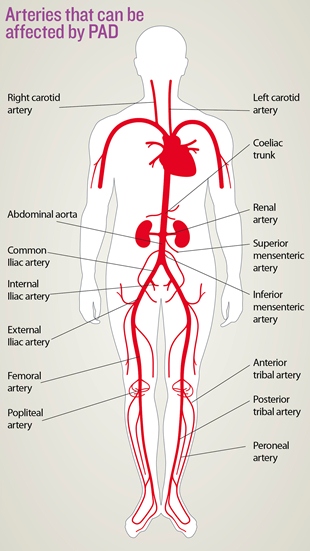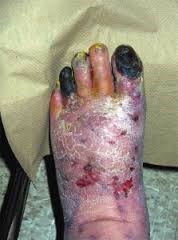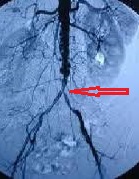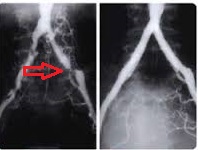What is peripheral arterial disease PAD?

Peripheral arteries of the body
All arteries that do not supply the heart or directly supply the brain are peripheral arteries. This diagram to your left shows these arteries. Many conditions can affect the walls of these arteries and cause the arteries to narrow or obstruct. This is peripheral arterial disease. Common conditions that increase a person’s risk of peripheral arterial disease are smoking, advanced age, diabetes mellitus, hyper- tension, hypercholesterolemia and male sex. Other situations or conditions include a family history of PAD, being overweight, an inactive life style, and past history of stroke or heart attack.
What problems can PAD cause?
It depends on the area of the body PAD affects.
- PAD of the large arteries in the neck can cause stroke.
- PAD of the kidney arteries cause hypertension and may lead to kidney failure.
- PAD of the arteries that supply the intestines can cause pain after meals, malabsorption, and weight loss.
- PAD of the arteries that supply the legs and feet can cause pain when walking as well as foot ulcers and gangrene when extreme. These can lead to amputa- tion of the leg or foot.
- PAD of the abdominal aorta can cause aneurysm that may rupture and cause death.
- PAD of the arteries that supply the penis may cause erectile dysfunction.

Gangrene by PAD

Narrow aorta by PAD
How do I know I have PAD?
If you have any of the conditions or lifestyles listed above, you have a higher chance of having PAD and if you have any of the symptoms or manifestations of the disease, consider seeing your physician. There are tests that will confirm or dismiss the disease in you, and if proven to have it, you will be referred to healthcare specialists to help you.
Is there treatment for PAD?
Yes, there is treatment for PAD. It starts with prevention: stopping smoking, better control of the blood sugar, cholesterol, and hypertension with medication reduce the risk of developing PAD and slow down its progression. But when the disease is advanced and causes much problem like leg cramping when walking or ulcer and gangrene of the feet, the narrow or obstructed artery can be bypassed by a surgeon in an operation. It can also be reopened by a vascular specialist like an interventional radiologist with special instruments that remove the obstruction or prop the artery open (stents).

Iliac PAD before + after stenting



